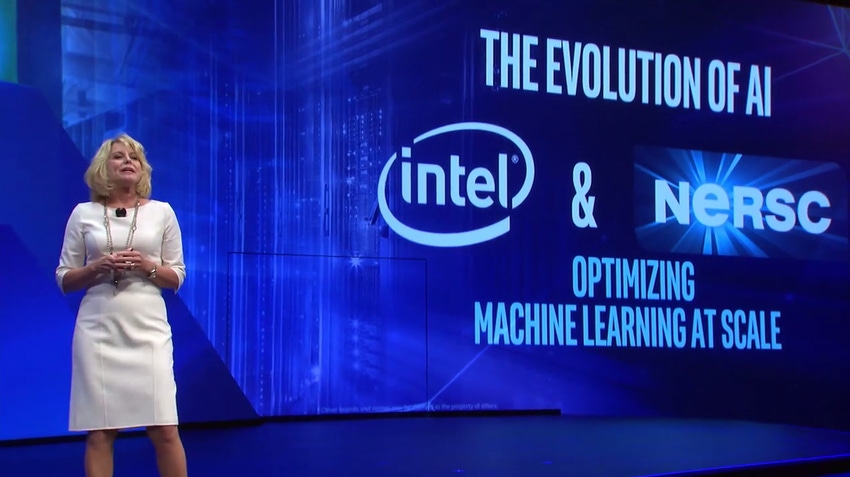Intel sets its crosshairs on artificial intelligence
Intel has set its targets on the world of artificial intelligence, as it continues to bolster its armoury to capitalize on the potentially lucrative IoT segment.
August 18, 2016

Intel has set its targets on the world of artificial intelligence, as it continues to bolster its armoury to capitalize on the potentially lucrative IoT segment.
Speaking at Intel Developer Forum, Diane Bryant GM of Intel’s Data Center Group outlined the ambitions of the business, with the finish line pointed towards artificial intelligence. There are still hurdles to be overcome over the next few years, as technology needs to catch up with the potential, though Bryant highlighted the $400 million acquisition of AI start-up Nervana shows the ambitions of the business.
Only last week Intel announced it was acquiring deep learning specialists Nervana, though the move towards IoT, of which AI could be seen as a crucial aspect, has not been a secret. Back in April, CEO Brian Krzanich made it very apparent IoT was one of the more prominent pillars of the company’s strategy, and this was echoed in Bryant’s talk.
“It is an exciting time to be in the tech industry,” said Bryant. “From the opportunities which are being unleased by cloud computing, to the transformation of the network and the move to 5G to the emergence of artificial intelligence and the opportunity to change the way people engage with the world. The data centre is the centre of possibility and we look forward to making the future.”
Despite the fury of articles and excitement which is surrounding the growth of artificial intelligence, there are still hurdles to overcome. First and foremost, the cloud needs to be addressed.
“Cloud is the big disruptor of the information and technology world, and we have been talking about cloud for a very long time, at least five years now,” said Bryant. “The way I see it, the future is going to be thousands and thousands of clouds, delivering millions and millions of services, connecting billions of devices and things, serving the world’s consumers and businesses. As an industry we have stabled out and the future is hybrid. No one cloud will service all needs.”
If bringing cloud into the world of enterprise IT was considered a challenge, incorporating a fluid and efficient multi-cloud environment will be as much of a test, if not more. Understanding what workloads need to be prioritized in which cloud environment, and in what location, could see a number of growing pains in the first instance, though there could be a long-term benefit.
The idea of data residency has been an issue since data regulations were called into question over the course of the last twelve months. The different cultural approaches to data on either side of the Atlantic has had IT decision makers twitching in Europe, though an efficient multi-cloud business model where decision makers can reliably dictate where data resides, should ease some of these concerns. This approach will also remove any concerns the EU-US Privacy Shield is not robust enough to withstand scrutiny from the European Court of Justice.
Aside from residency concerns, according to Bryant, the cloud has to be more efficient before any of the promised technologies can be considered a reality. One step which may prove to be decisive is the shift from localised to globalised IT management. “To make this achievable we need to move the standard unit of computer from the server to the rack,” said Bryant. “We need to move from local optimization to global optimization.”
If changing the business wasn’t enough of a challenge, network connectivity will also have to improve before artificial intelligence can be realized. Intel claim data centre traffic is now five times as large as internet traffic, with east-west traffic doubling every year. Data centres are built on fibre optics, which Bryant claims can now exceed 50% of data centre upgrades and it’s only going up. But not to worry, Intel has a solution to increase efficiency of network connectivity in the data centre, while also keeping the price down; Silicon Photonic Modules. For a more detailed look into Intel’s Silicon Photonic Modules check out the story our sister-site Light Reading put together.
Should the plan run smoothly, complex artificial intelligence systems will be prominent in the industry before anyone realizes. For the most part, AI’s current role is overlooked, whether it would be auto-tagging photos or predictive text, though the long-term promise of AI is somewhat more complex. Whether it would be precision medicine, autonomous vehicles or maintenance prediction, machine learning and deep learning are the key areas of expanding the remit of AI.
“Machine learning and deep learning training is a distributed, parallel, high performance workload,” said Bryant. “The maths for machine learning and deep learning is not new and not complex, it simple linear algebra, but what is new is the enormous scale. The more data that you can compute, the more accurate your model, and the more compute you can throw at the problem the faster the model will train and converge.”
The potential for AI and IOT has been well documented throughout the industry; however there are still hurdles to overcome in the near future. Intel carved itself a leadership position in the data centre market, though it largely missed out on the smartphone revolution. What is apparent is that the team intends to be fully prepared to capitalize on the IoT craze.
About the Author(s)
You May Also Like








.png?width=300&auto=webp&quality=80&disable=upscale)


_1.jpg?width=300&auto=webp&quality=80&disable=upscale)


.png?width=800&auto=webp&quality=80&disable=upscale)